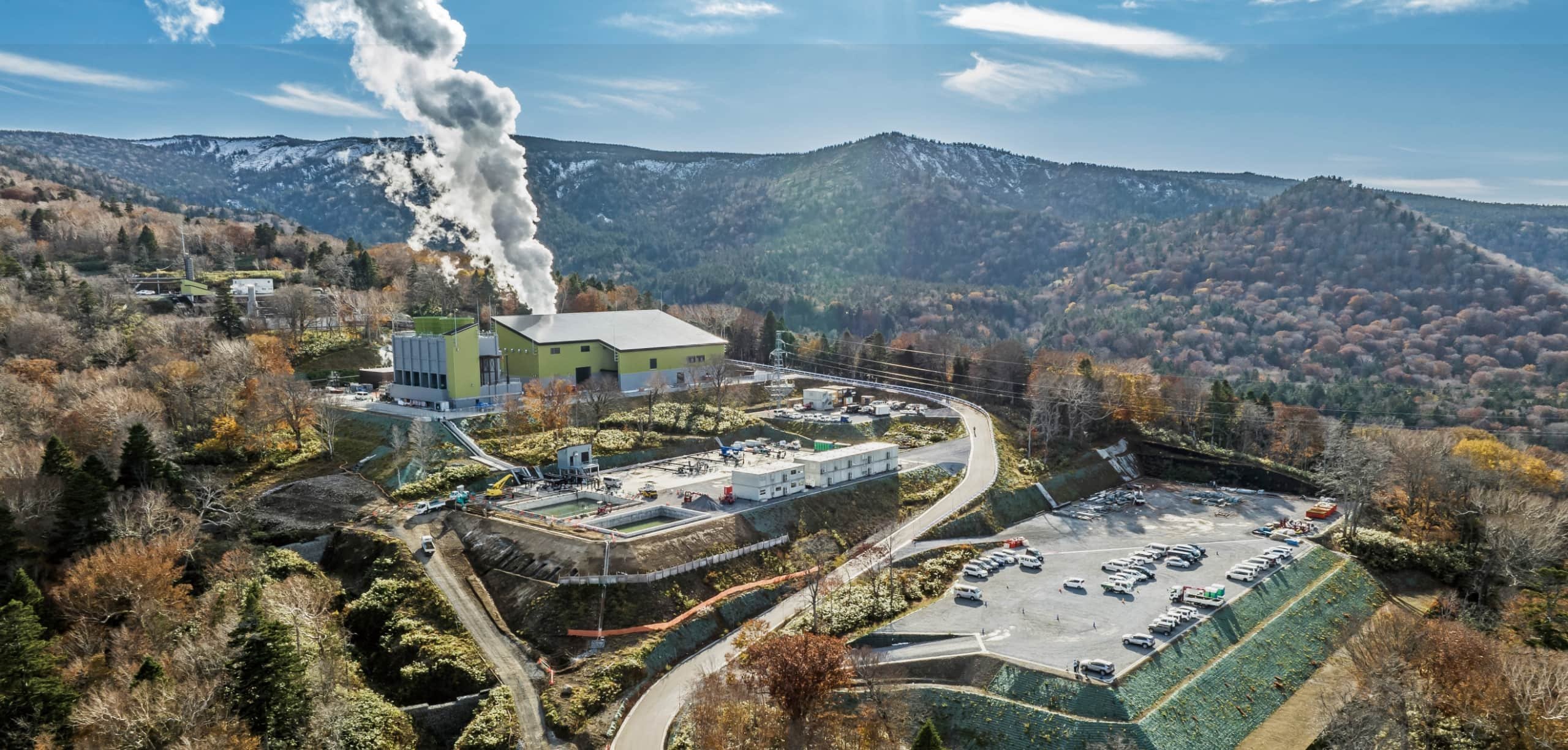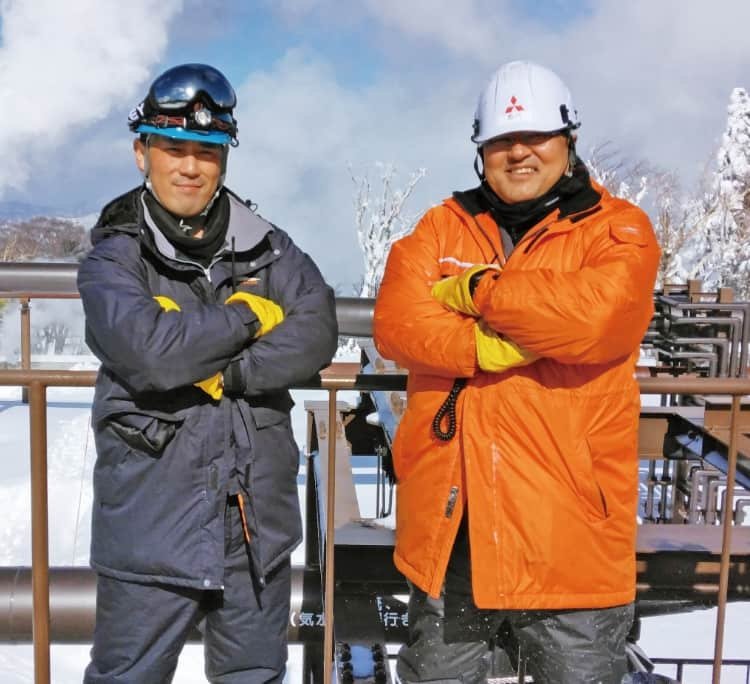
Aiming for 100% Self-Sufficiency
in Renewable Energy
Taking on the Challenge
of Carbon Neutrality
with Geothermal Power Generation
- Home
- Corporate
- Our Commitment
- Guideline to achieve "Our Commitment"
- Our Current Challenges
- Taking on the Challenge of Carbon Neutrality with Geothermal Power Generation
The key to
Mitsubishi Materials' success
with zero
emissions lies
with geothermal power generation
Mitsubishi Materials has set its target year for achieving carbon neutrality as the fiscal year ending March 2046, five years ahead of the government's target year of the fiscal year ending March 2051, and is working to utilize renewable energy and reduce greenhouse gases (GHG). Additionally, by the fiscal year ending March 2051, Mitsubishi Materials aims to achieve renewable energy generation equivalent to the electricity consumed internally, thereby achieving 100% self-sufficiency in renewable energy.
The key to success lies with geothermal power generation. In Japan, a country blessed with abundant geothermal resources, there are high expectations for the possibilities of geothermal power generation, which can stably supply electricity regardless of weather conditions. Based on 50 years of geothermal power generation experience, Mitsubishi Materials is carrying out stable renewable energy development and power generation projects.
One of its latest projects is the Appi Geothermal Power Plant, which commenced operation in March 2024 in Iwate Prefecture. Currently, the plant generates 14,900kW of electricity, and is managed and operated by Appi Geothermal Energy Corporation (AGE), which is jointly funded by three companies, including Mitsubishi Materials.
Passing on clean energy
to the future,
along with
technical capabilities and aspirations
for the next generation
We spoke with Tatsumi Abe from Mitsubishi Materials, who led the Construction Project of Appi Geothermal Power Plant, and Gaku Sasaki from AGE about the challenges they have overcome as well as their vision for geothermal power generation and the future it could bring.

Gaku Sasaki
Chief, Engineering Department
Appi Geothermal Energy Corporation
Tatsumi Abe
General Manager, Geothermal
Business Development Dept.
Renewable Energy Business Div.
Mitsubishi Materials Corporation

Gaku Sasaki
Chief, Engineering Department
Appi Geothermal
Energy Corporation
Tatsumi Abe
General Manager,
Geothermal Business
Development Dept.
Renewable Energy
Business Div.
Mitsubishi Materials Corporation
Geothermal power generation involves extracting hot, high-pressure water and steam from geothermal reservoirs about 2,000 meters underground. This water possesses high energy due to being heated by magma, and the steam can be used to rotate turbines and generate electricity. This is why geothermal power generation development requires drilling production wells*1 and reinjection wells*2. The leader of the Drilling and Reservoir Section, who will be responsible for the successful completion of the drilling work for these wells, must have the appropriate knowledge.
The person selected as leader of the Drilling and Reservoir Section was Abe, who has spent over half of his career working in the geothermal business. Looking back on the past, Abe says, "These four years were full of challenges, but the largest was drilling the wells. We spent about three months drilling each one. During the final phase, the temperature exceeded 200ºC, so it truly felt like a battle against the magma."
Abe explained that although preliminary investigations are carried out for drilling, it's impossible to know everything that goes on underground from the surface. "For example, there is a risk that the steam won't discharge after drilling, or conversely, that magma-heat steam suddenly blows out in the middle of drilling," elaborates Abe. "We adequately prepare for these incidents, but it's frightening to be going up against nature. Nevertheless, we must extract enough steam to operate a geothermal power plant at full scale. That is our mission. Mr. Sasaki and other young engineers worked to make the situation underground predictable in order to properly fulfill this mission."

Abe explained that although preliminary investigations are carried out for drilling, it's impossible to know everything that goes on underground from the surface. "For example, there is a risk that the steam won't discharge after drilling, or conversely, that magma-heat steam suddenly blows out in the middle of drilling," elaborates Abe. "We adequately prepare for these incidents, but it's frightening to be going up against nature. Nevertheless, we must extract enough steam to operate a geothermal power plant at full scale. That is our mission. Mr. Sasaki and other young engineers worked to make the situation underground predictable in order to properly fulfill this mission."
This project was Sasaki's second time working with Abe as he had managed the steam equipment of a geothermal power plant under Abe's supervision in his second year with the company. As an employee of AGE, Sasaki participated in this project in a different position from Abe. "To reduce drilling risks, even by a little, we attempted to visualize the geological structure by utilizing the latest modeling tools. We also anticipated the location of the geothermal reservoir based on the data and drilled accordingly. When we succeeded in digging it up, I felt relieved from the bottom of my heart," Sasaki explains.
With Appi Geothermal Power Plant having commenced operation after overcoming these difficulties, we asked the two about the next challenge.
"While the expansion of geothermal power generation is crucial, operating and managing existing geothermal power plants is equally important," Sasaki states while looking straight ahead. "Therefore, I will first focus on the stable operation of the Appi Geothermal Power Plant. Operating a large-scale power plant like the Appi Geothermal Power Plant presents a rare opportunity. I will thoroughly absorb this experience to utilize it for the next geothermal power generation development project."
Hearing Sasaki's words, Abe remarks, "Starting operation is not our end goal, but it is important to ensure stable operation while maintaining high standards of output. Looking back, our company has been working on this project for over 20 years, starting from the investigation stage. This means that the blood, sweat, and tears shed by our predecessors have finally paid off." With a smile, Abe continues, "Now, it's our turn to pass on everything we have, including knowledge, experience, and aspirations, to the next generation. Going forward, I am eager to contribute to the development of the geothermal power generation business by nurturing future generations. Mitsubishi Materials handles not only geothermal but also hydroelectric and solar power generation, but as the leader of the Drilling and Reservoir Section, I would like to further invigorate geothermal development."
These two, who were central figures in this project, are looking ahead to the future beyond stable operation and toward the next challenge.
*1 Production well: A well that discharges steam from the geothermal reservoir
*2 Reinjection well: A well that returns hot water to the geothermal reservoir








